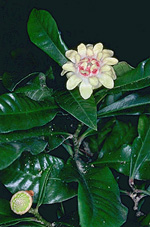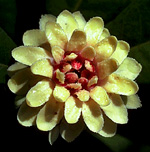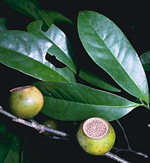 |
The Eupomatiaceae are a small, primitive family comprising the single genus Eupomatia, two species of which are found in eastern Australia and eastern Papua New Guinea, on rain forest margins or in wet sclerophyll forests at low altitudes.
Characteristic features of the family Eupomatiaceae in Australia include: - aromatic shrubs with simple, rather thick, alternate leaves which are often 2-ranked and borne on arching stems
- flowers single in the leaf axils, robust, covered in bud by a conical cap which falls complete
- stamens numerous, spirally arranged, thick, fleshy and petal-like with marginal pollen-sacs
- ovary of numerous carpels sunk in the floral receptacle, maturing into a fleshy, flat-topped, berry-like fruit
Description
Evergreen trees or shrubs. Vegetative reproduction absent or by tubers. Internal secretions not obvious. Plants glabrous, or with simple or dendritic, non-glandular, uniseriate hairs. Leaves alternate and spiral, or distichous, petiolate. Stipules absent. Lamina simple, symmetric, filiform, acicular, subulate, linear, elliptic, oblanceolate, obovate or oblong; base cuneate or attenuate; margins entire, ±flat; venation pinnate, with the midrib conspicuous, and the tertiary venation reticulate; surfaces punctate or not punctate; herbaceous or leathery; distinctive odour present or absent. All the flowers bisexual. Inflorescences terminal or axillary, consisting mostly of solitary flowers, or rarely of cymes. Bracts present. Bracteoles present or absent. Pollination by insects. Flowers fragrant; stalked. Floral disc absent; nectaries absent. Perianth regular, apparently of 1, fused, sepaloid whorl, bell-shaped or cup-shaped, green, without contrasting markings, herbaceous. Fertile stamens numerous, not clearly correlated with the perianth, free of the ovary and style, distinct from each other, all ±equal. Staminodes numerous, petaloid, white, cream, yellow, red, pink or green. Staminal filaments distinctly flattened, with conventional anthers or embedded anther-sacs. Anthers basifixed, not versatile, opening sideways or inwards by short slits or by longitudinal slits, 2-celled. Ovary inferior. Carpels 13–numerous, fused, incompletely closed; ovary with 13–numerous locules. Style absent and the stigma sessile. Ovules 2–11 per locule, stalked; placentation laminate. Fruit fleshy, indehiscent, berry-like (pometum); the perianth on the maturing fruit dry and persistent. Disseminule micro-surface ±smooth, yellow, orange, green or brown, dull. Seeds numerous per fruit. Aril absent. Cotyledons 2. Embryo ?straight.
(Note: this description has been generated from the coded data compiled for the key. Any errors in the key data will be reflected in the descriptions.)
A treatment of the family Eupomatiaceae has not yet been published in the Flora of Australia. It will appear in Volume 2.
Australian genera of Eupomatiaceae (as recognised for the Flora of Australia)
Eupomatia

|
  |

Eupomatia bennettii (flower and fruit)
Photo: M.Fagg © ANBG

Eupomatia bennettii (flower)
Photo: H.Nicholson © H. & N. Nicholson

Eupomatia laurina (fruits)
Photo: H.Nicholson © H. & N. Nicholson
|

| |